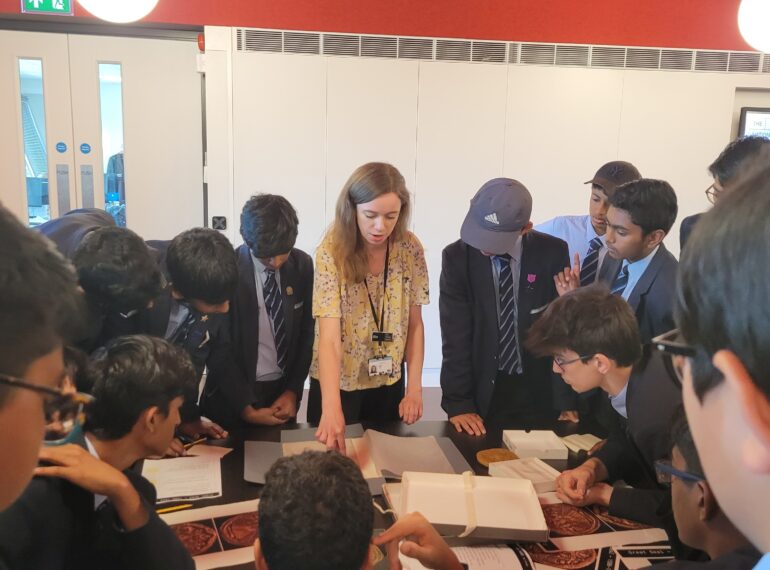
Twenty-three boys whose work was chosen as the best in the QE 450th anniversary research project were treated to a rare look at one of the nation’s most treasured documents on a trip to the National Archives.
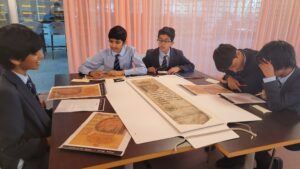 Among the artefacts viewed by the group during their visit to Kew was the actual letter – known as the ‘Tide Letter’ – written by the future Queen Elizabeth I, founder of Queen Elizabeth’s School, as she battled for survival following her arrest in 1554.
Among the artefacts viewed by the group during their visit to Kew was the actual letter – known as the ‘Tide Letter’ – written by the future Queen Elizabeth I, founder of Queen Elizabeth’s School, as she battled for survival following her arrest in 1554.
Jenni Blackford, Curator of QE Collections and Head of Library Services, said: “It was amazing to see such fabulous documents close up and it was a testament to our students’ conduct, interest and behaviour that they brought the Tide Letter out to show them at the end of the session.”
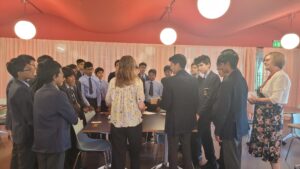 The visit was a reward for the boys who submitted the best entries to Project 1573. This involved small groups of boys being given three primary sources relating to a particular aspect of QE’s history and then asked to produce a three-minute presentation after accessing QE Collections – the School’s online archive – and other archival materials.
The visit was a reward for the boys who submitted the best entries to Project 1573. This involved small groups of boys being given three primary sources relating to a particular aspect of QE’s history and then asked to produce a three-minute presentation after accessing QE Collections – the School’s online archive – and other archival materials.
The winners were:
- Navieeneish Kirubaharan, Param Kapadia, Aarnav Mahajan and Advay Zore, all from Year 8 Pearce form, who researched Timothy Edwards, Headmaster 1961–1983
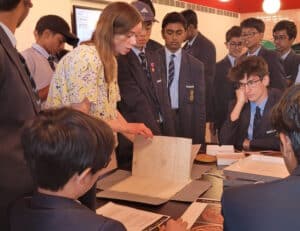 Kelvin Chen, Ethan Yao, Jonas Dawit and Rishi Sen, also of Year 8 Pearce, researching E W Harrison, a long-serving teacher who retired in 1950 and is one of the two unrelated people after whom the Harrisons’ House is named
Kelvin Chen, Ethan Yao, Jonas Dawit and Rishi Sen, also of Year 8 Pearce, researching E W Harrison, a long-serving teacher who retired in 1950 and is one of the two unrelated people after whom the Harrisons’ House is named- Shravanth Sadheesh, Pranav Nayak, Arya Ratnakaram and Sriram Muthukumaran, from Year 8, Stapylton, who looked into QE’s 350th anniversary celebrations in 1923
- Snehal Das, Samir Cheema and Ozgan Cakir, of Year 9, Stapylton, who researched QE becoming a grant-maintained school in 1989, giving it new freedoms to govern its own affairs
- Keeyan Shah, Alex Stack, Shlok Gajjar and Pranith Turaga, also of Year 9, Stapylton, looked into the foundation of the School
- Aahan Shah, Abhinav Sandeep, Jack Tan and Tunishq Mitra, of the Year 9 Broughton form, who investigated the history of Eton Fives at the School.
They saw the Tide Letter, which was written by Elizabeth to her half-sister, Queen Mary I, when the princess was arrested following Wyatt’s Rebellion, an attempt to overthrow the queen, in 1554. Mary gave orders for Elizabeth to be taken to the Tower of London.
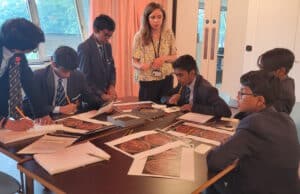 “The students were able to see the neat handwriting at the start of the letter become larger and messier as she was likely made to hurry by those waiting to escort her to the Tower. Fearing her enemies might alter the letter, Elizabeth struck lines through the blank space above her signature,” said Mrs Blackford.
“The students were able to see the neat handwriting at the start of the letter become larger and messier as she was likely made to hurry by those waiting to escort her to the Tower. Fearing her enemies might alter the letter, Elizabeth struck lines through the blank space above her signature,” said Mrs Blackford.
“It is called the Tide Letter because it is believed Elizabeth deliberately wrote the letter to buy time so that the daylight low tide that enabled boats to pass safely through the narrow arches of London Bridge would have turned and she would avoid being taken to the Tower for an additional day.”
Eloquently protesting her innocence, the future queen finishes the letter: “Your hignes most faithful subject that hathe bine from the beginninge, and wylbe to my ende. Elizabeth.”
Her stratagem was successful: she was not taken to the Tower until the following day. Elizabeth was eventually released and then succeeded to the throne on Mary’s death four years later, in 1558.
The Year 8 and Year 9 boys saw a variety of later documents from Elizabeth’s reign, including letters, speeches, Plea Rolls (parchment court records) and the queen’s second Great Seal.
 QE’s founding Royal Charter of 1573 was authorised with Queen Elizabeth’s first seal. This, however, wore out during her long reign, and, Ms Blackford said, the boys enjoyed finding out about its replacement: “It is noticeably more elaborate, as Elizabeth had started to closely monitor her image.”
QE’s founding Royal Charter of 1573 was authorised with Queen Elizabeth’s first seal. This, however, wore out during her long reign, and, Ms Blackford said, the boys enjoyed finding out about its replacement: “It is noticeably more elaborate, as Elizabeth had started to closely monitor her image.”
The boys also learned about how the National Archives came into existence, hearing how in the 1830s, civil servant Henry Cole submitted to the Government a dead mummified rat with a stomach full of chewed documents among his evidence of the unsuitability of the premises where public records were then being stored.

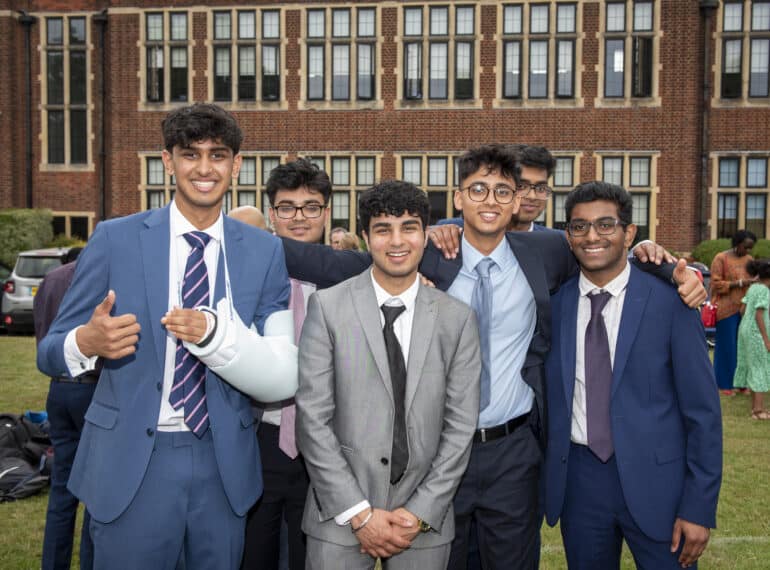
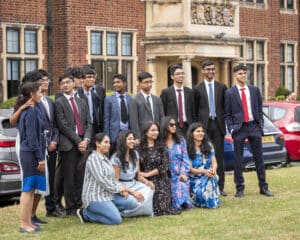 There were prizes for some, while the contribution of all the leavers – or graduands – was celebrated during an occasion in Shearly Hall that featured speeches and presentations, followed by afternoon tea on Staplyton Field.
There were prizes for some, while the contribution of all the leavers – or graduands – was celebrated during an occasion in Shearly Hall that featured speeches and presentations, followed by afternoon tea on Staplyton Field.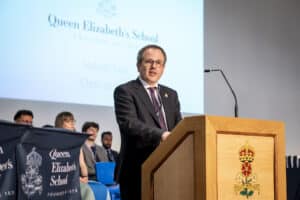 Headmaster Neil Enright thanked parents for their “huge support, both moral and financial, over the years” and urged both them and their sons to stay in touch with the School.
Headmaster Neil Enright thanked parents for their “huge support, both moral and financial, over the years” and urged both them and their sons to stay in touch with the School. Sahil attended Valediction together with his mother, cousin, friends and his brother, Nikhil Handa (OE 2013–2020). He recalled his first encounter with Deputy Head (Pastoral) David Ryan, who hauled him over the coals after spotting him dancing outside the classroom window to entertain his classmates during afternoon form time. This less-than-auspicious beginning soon turned into a supportive relationship, however, when he became part of Mr Ryan’s English class. “I thought he’d make my life miserable. But to my surprise, it seemed as though he’d forgotten the whole episode entirely. I went on to learn everything from him… Mr Ryan was also the first person who complimented me for being a generalist.”
Sahil attended Valediction together with his mother, cousin, friends and his brother, Nikhil Handa (OE 2013–2020). He recalled his first encounter with Deputy Head (Pastoral) David Ryan, who hauled him over the coals after spotting him dancing outside the classroom window to entertain his classmates during afternoon form time. This less-than-auspicious beginning soon turned into a supportive relationship, however, when he became part of Mr Ryan’s English class. “I thought he’d make my life miserable. But to my surprise, it seemed as though he’d forgotten the whole episode entirely. I went on to learn everything from him… Mr Ryan was also the first person who complimented me for being a generalist.”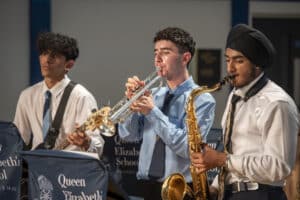 A large majority of Year 13 students attended. All received a set of QE cufflinks, while the prizewinners also received a copy of former Headmaster Dr John Marincowitz’s new history of the School, Queen Elizabeth’s School: 1573–2023. Among the speakers was Theo Mama-Kahn, School Captain 2022, who was one of the leavers. He gave a vote of thanks.
A large majority of Year 13 students attended. All received a set of QE cufflinks, while the prizewinners also received a copy of former Headmaster Dr John Marincowitz’s new history of the School, Queen Elizabeth’s School: 1573–2023. Among the speakers was Theo Mama-Kahn, School Captain 2022, who was one of the leavers. He gave a vote of thanks.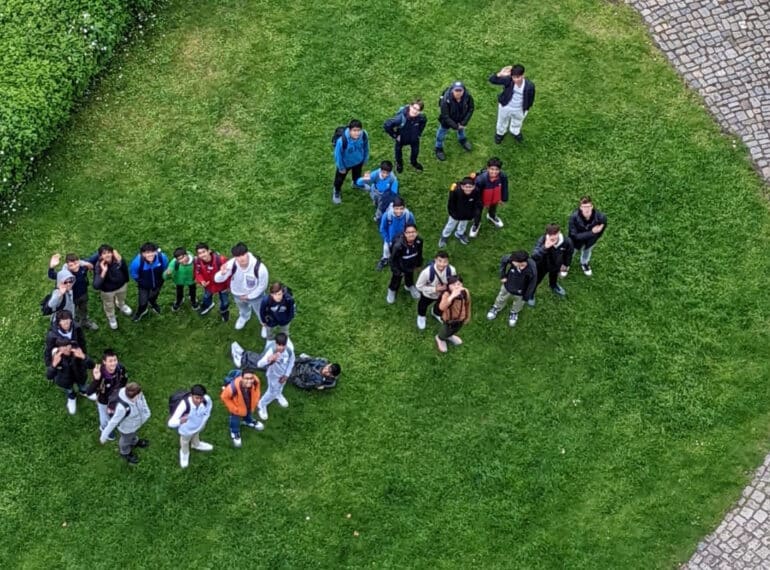
 The Year 9 trip to the north German city of Bielefeld saw the QE party enjoy the high life at one of the world’s tallest and fastest roller-coasters, at a tree-climbing adventure park and at the mediaeval Sparrenberg Castle (known locally as the Sparrenburg), which towers over the city centre.
The Year 9 trip to the north German city of Bielefeld saw the QE party enjoy the high life at one of the world’s tallest and fastest roller-coasters, at a tree-climbing adventure park and at the mediaeval Sparrenberg Castle (known locally as the Sparrenburg), which towers over the city centre.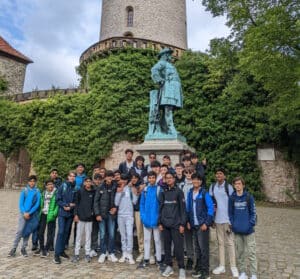 The exchange, which began in 2005, is with a co-educational grammar school (or ‘Gymnasium’), Friedrich von Bodelschwingh Gymnasium in Bielefeld. The school is named after a German pastor, theologian and public health advocate, who ran large homes for people with learning difficulties and refused to comply with the Nazis’ euthanasia policies.
The exchange, which began in 2005, is with a co-educational grammar school (or ‘Gymnasium’), Friedrich von Bodelschwingh Gymnasium in Bielefeld. The school is named after a German pastor, theologian and public health advocate, who ran large homes for people with learning difficulties and refused to comply with the Nazis’ euthanasia policies. Music: the boys created their own digital music using GarageBand software. One of the party, Peter Atanasov, said: “We made our own beats on iPads to accompany a melody and learnt about new music genres as well.”
Music: the boys created their own digital music using GarageBand software. One of the party, Peter Atanasov, said: “We made our own beats on iPads to accompany a melody and learnt about new music genres as well.”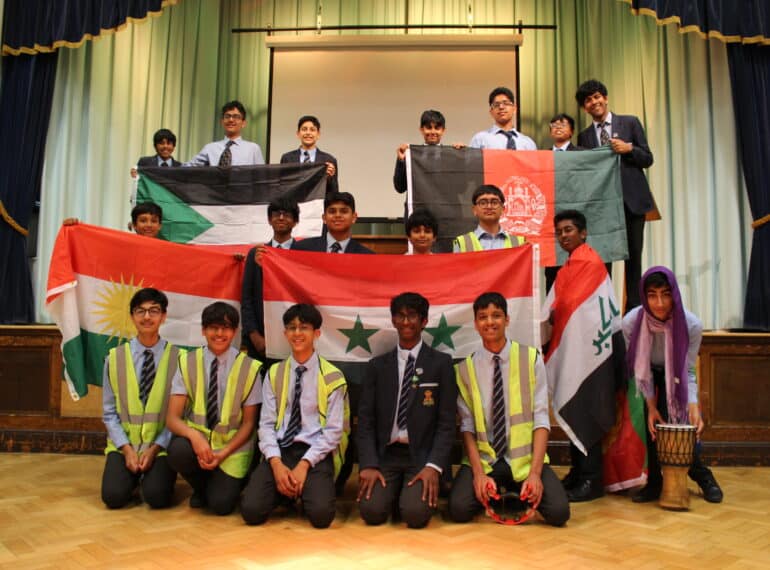
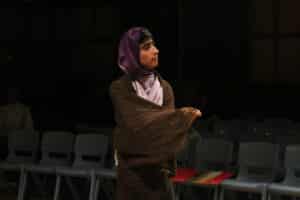 Performed during national Refugee Week, the play, which is itself called The Jungle, gave a voice to some of the thousands of men, women and children from many different countries who lived in the camp while trying to gain access to the UK.
Performed during national Refugee Week, the play, which is itself called The Jungle, gave a voice to some of the thousands of men, women and children from many different countries who lived in the camp while trying to gain access to the UK.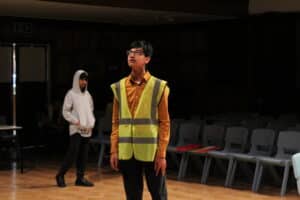 An award-winning play, The Jungle was written by two young playwrights, Joe Murphy and Joe Robinson, who met while studying English at Oxford. In the autumn of 2015, they first came to the Jungle camp, returning a short time later after crowdfunding to bring an 11m white geodesic dome there to serve as a theatre and community & arts space. They then spent seven months volunteering in the Jungle, before the authorities took down the encampment in 2016.
An award-winning play, The Jungle was written by two young playwrights, Joe Murphy and Joe Robinson, who met while studying English at Oxford. In the autumn of 2015, they first came to the Jungle camp, returning a short time later after crowdfunding to bring an 11m white geodesic dome there to serve as a theatre and community & arts space. They then spent seven months volunteering in the Jungle, before the authorities took down the encampment in 2016. Aahan said: “Playing the role of someone who has been far less privileged than myself and has had many different experiences has been really interesting. Additionally, the character I played weaves himself in and out of the story, as if controlling it and the perspective, which was something really challenging but also really fun!”
Aahan said: “Playing the role of someone who has been far less privileged than myself and has had many different experiences has been really interesting. Additionally, the character I played weaves himself in and out of the story, as if controlling it and the perspective, which was something really challenging but also really fun!”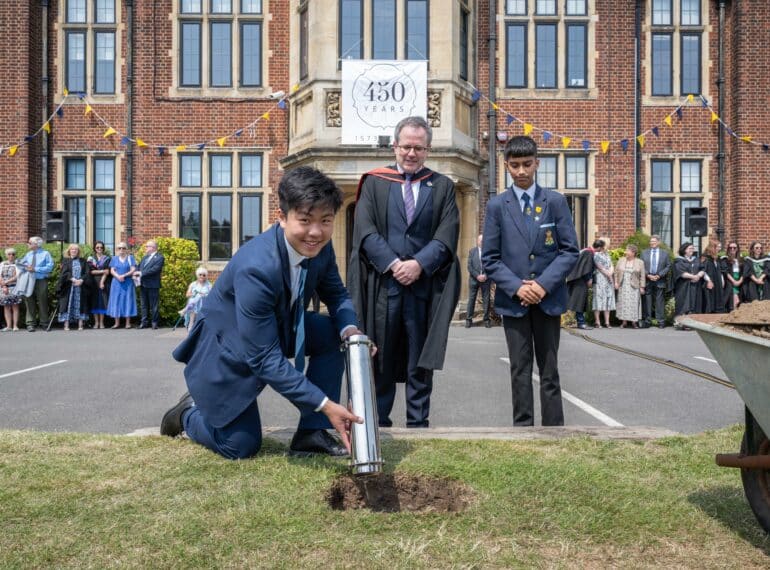
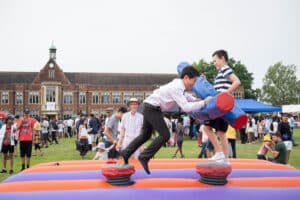 Always a highlight of the School calendar, Founder’s Day this year featured a string of anniversary-related special events, including the burial of a time capsule, as well as time-honoured traditions, from the reading of the School Chronicle to a cricket match between the current School XI and alumni.
Always a highlight of the School calendar, Founder’s Day this year featured a string of anniversary-related special events, including the burial of a time capsule, as well as time-honoured traditions, from the reading of the School Chronicle to a cricket match between the current School XI and alumni.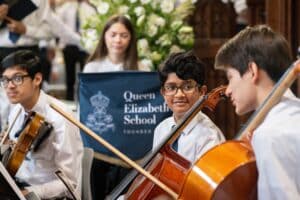 Headmaster Neil Enright said: “Our anniversary slogan is ‘thriving from ancient roots’ – and Founder’s Day 2023 exemplified this to the full. In the morning we reflected together on our long and rich history in the thanksgiving service at the parish church, while the happy crowds at our colourful afternoon fete were a reminder of just how vibrant and successful is the Elizabethan community of today.
Headmaster Neil Enright said: “Our anniversary slogan is ‘thriving from ancient roots’ – and Founder’s Day 2023 exemplified this to the full. In the morning we reflected together on our long and rich history in the thanksgiving service at the parish church, while the happy crowds at our colourful afternoon fete were a reminder of just how vibrant and successful is the Elizabethan community of today.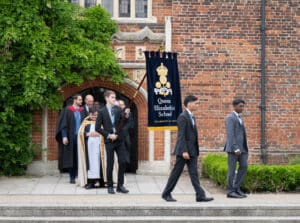 “My thanks go to the small army of people – including FQE volunteers, staff and pupils – who made the day such a success, and to the many who contributed so generously to maximising FQE’s income, which will be invested in the School.
“My thanks go to the small army of people – including FQE volunteers, staff and pupils – who made the day such a success, and to the many who contributed so generously to maximising FQE’s income, which will be invested in the School.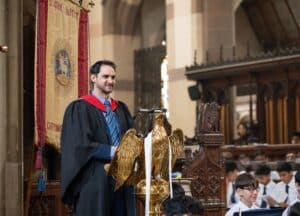 There, Giles Martin (OE 1992–1999) the son of the Chairman of Governors and the Programme Leader for Higher Education Practice at Bath Spa University’s School of Education, reminded the boys and wider congregation of the words of Gandhi: “Live as if you were to die tomorrow. Learn as it you were to live forever.”
There, Giles Martin (OE 1992–1999) the son of the Chairman of Governors and the Programme Leader for Higher Education Practice at Bath Spa University’s School of Education, reminded the boys and wider congregation of the words of Gandhi: “Live as if you were to die tomorrow. Learn as it you were to live forever.”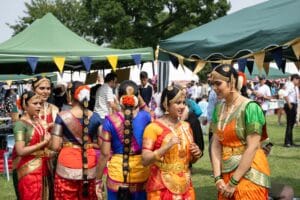 School Captain Darren Lee, of Year 12, stepped forward to fill the deep hole dug for the time capsule. This included:
School Captain Darren Lee, of Year 12, stepped forward to fill the deep hole dug for the time capsule. This included: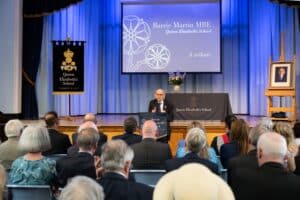 A photographic portrait of Barrie will be placed in the ‘crush hall’ in the Main Building upon his retirement. It was taken by the School’s photographer Eleanor Bentall, who has also taken portraits of subjects including Boris Johnson, former Archbishop of Canterbury Dr Rowan Williams, Clare Balding and Tinie Tempah.
A photographic portrait of Barrie will be placed in the ‘crush hall’ in the Main Building upon his retirement. It was taken by the School’s photographer Eleanor Bentall, who has also taken portraits of subjects including Boris Johnson, former Archbishop of Canterbury Dr Rowan Williams, Clare Balding and Tinie Tempah. The ever-popular international food tents were extended this year, while there was a range of impressive culinary creations battling it out in the Cake Competition. Additional attractions included a VEX Robotics tent – popular with parents as much as anyone! – and Ju Jitsu, where, rumour has it, Barrie Martin was seen performing a martial arts hold.
The ever-popular international food tents were extended this year, while there was a range of impressive culinary creations battling it out in the Cake Competition. Additional attractions included a VEX Robotics tent – popular with parents as much as anyone! – and Ju Jitsu, where, rumour has it, Barrie Martin was seen performing a martial arts hold. At the back of the School, the Stanley Busby Memorial Cricket Match on Third Field saw the old boys claiming what Head of Cricket Richard Scally described as “a well-deserved victory”. He added: “Both openers for the OEs – Omar Mohamed and Shahil Sheth – scored quickly, amassing 50 runs each and setting a challenging total of 159. In reply, the School lost early wickets and the run rate became too high, and although there was some strong resistance from Year 12’s Rohan Belavadi and Ranvir Sinha, it all proved too little too late, and the old boys won by 39 runs.”
At the back of the School, the Stanley Busby Memorial Cricket Match on Third Field saw the old boys claiming what Head of Cricket Richard Scally described as “a well-deserved victory”. He added: “Both openers for the OEs – Omar Mohamed and Shahil Sheth – scored quickly, amassing 50 runs each and setting a challenging total of 159. In reply, the School lost early wickets and the run rate became too high, and although there was some strong resistance from Year 12’s Rohan Belavadi and Ranvir Sinha, it all proved too little too late, and the old boys won by 39 runs.”